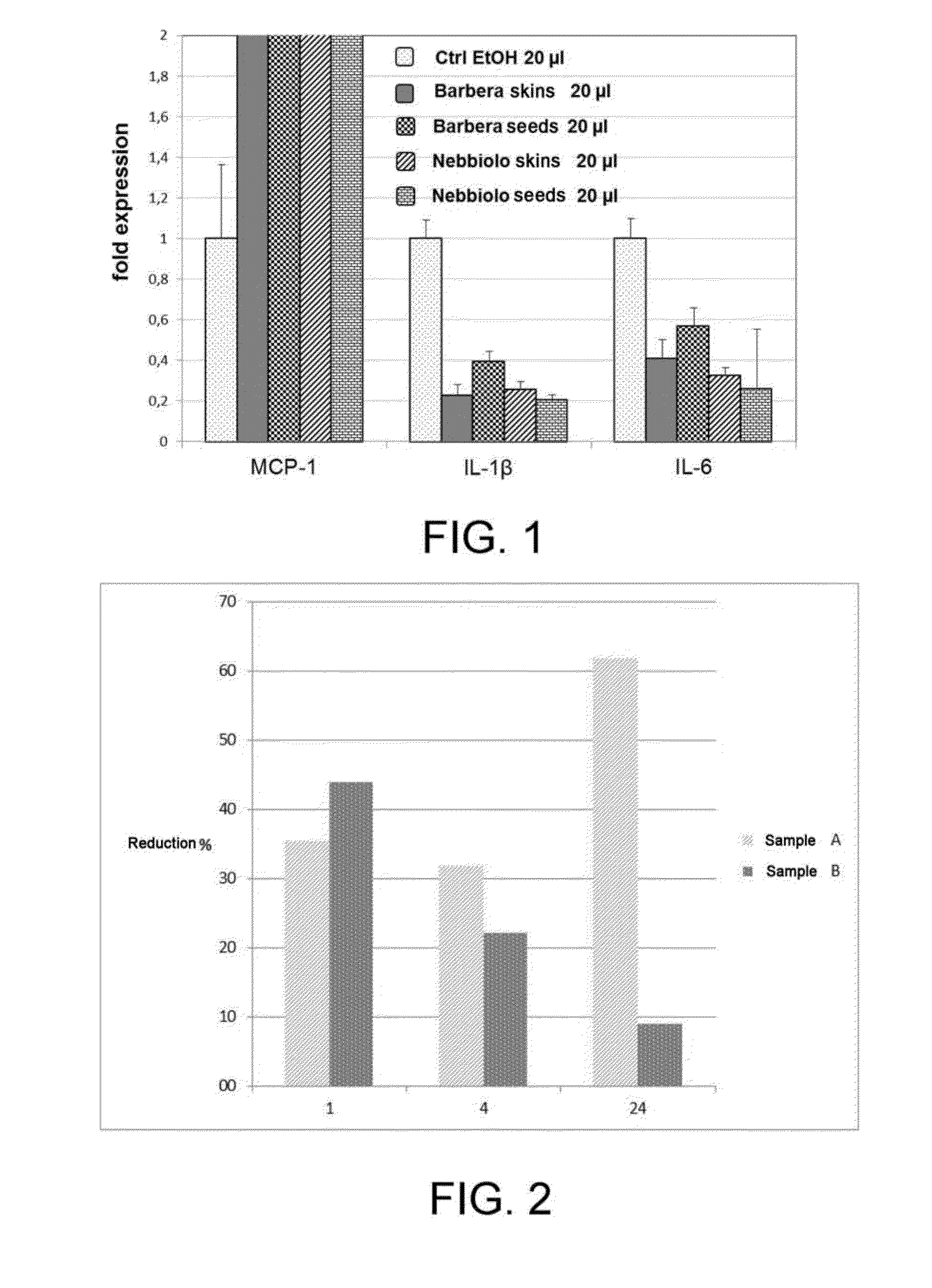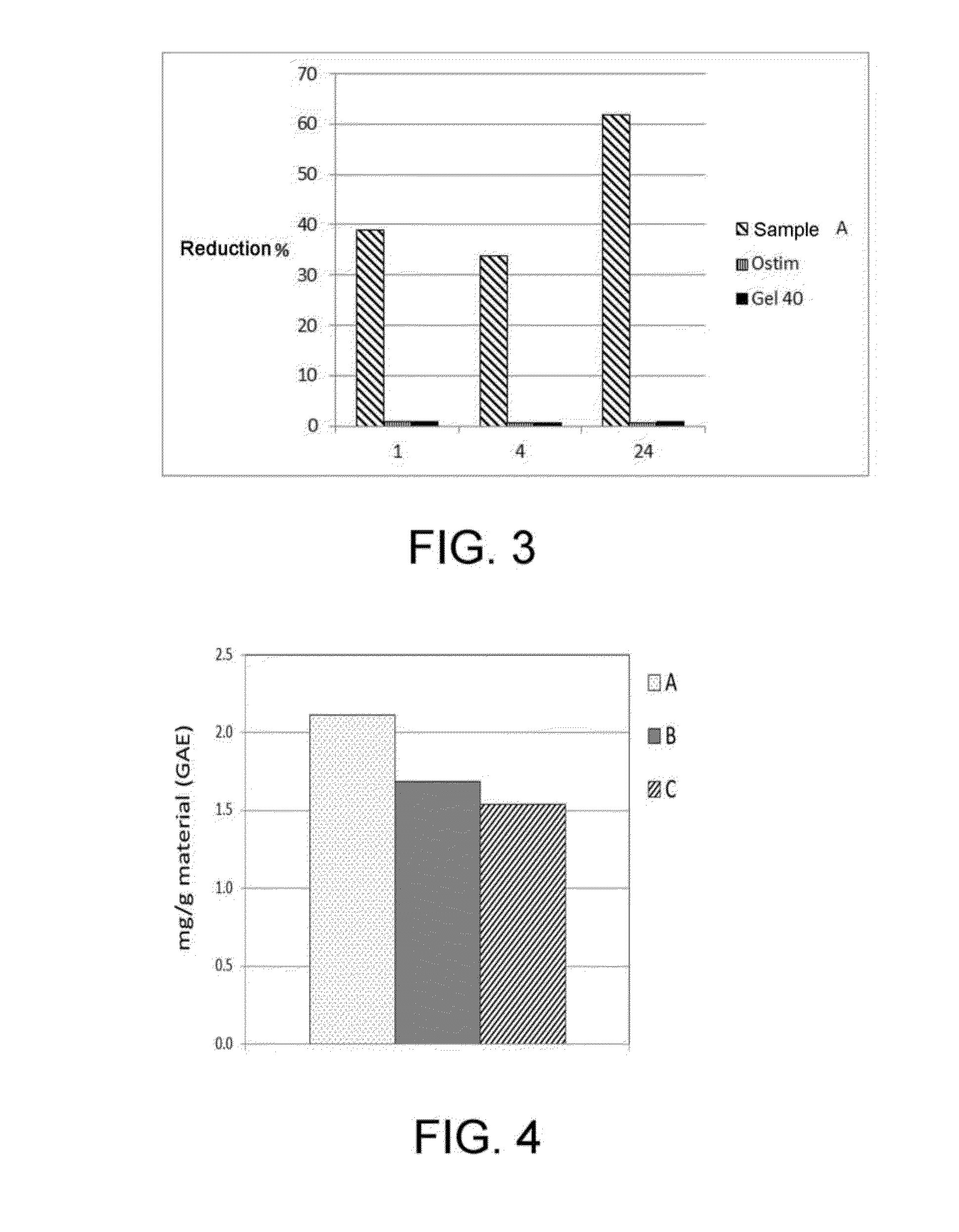Compositions for filling bone and periodontal defects
a technology of filling bone and periodontal defects, applied in dental prosthetics, dental impression caps, dentistry, etc., can solve the problems of lack of antioxidant activity such as reducing the formation of cytokines, lack of true promoter activity of periodontal and peri-implant defects, lack of material similarity, etc., to achieve easy and economical extraction, high solubility and stability, and simple and inexpensive manner
- Summary
- Abstract
- Description
- Claims
- Application Information
AI Technical Summary
Benefits of technology
Problems solved by technology
Method used
Image
Examples
example 1
[0059]Skins and seeds of various grape varieties (Nebbiolo, Barbera), residues of the wine-making process, are ground separately with a mixer to obtain a coarse flour. The flour is placed in contact with a 50% solution of water-ethanol in a 1:6 ratio by weight, and agitated on a shaker for 60 minutes. The extracts are separated from the flour by centrifugation and further filtered with 0.45 and 0.20 micrometre filters.
[0060]Aliquots of 20 micro litres are placed in macrophage cell cultures J774A1, a control consisting of 20 micro litres of the 50% water-ethanol mixture is also used. After 24 h an RT-PCR expression measurement is performed of some genes related to the inflammatory process, the results shown in FIG. 1 were obtained.
[0061]The data shows that all the extracts, without further fractionation and separation, significantly reduce the expression of the two interleukins evaluated. Both are expressed in inflammatory processes and contribute to the generation of osteoclasts whi...
example 2
[0062]The preparation of Example 1 is repeated with extracts from Nebbiolo grape skins, treated the same way. 5 ml of the hydroalcoholic solution thus obtained is placed in contact with 5 ml of Theracoll porcine collagen, in a 1% solution and vigorously stirred using a Thinky mixer stirrer at 500 revolutions per minute. This operation gives rise to a gel, formed due to the cross-linking of collagen, applicable to periodontal or peri-implant defects using a syringe or spatula.
example 3
[0063]The gel obtained according to example 2 is mixed with a granulate bone filler consisting of a ceramic matrix made of a mixture of hydroxyapatite and tricalcium phosphate. A filler material is obtained which is easy to use clinically, similarly to existing products, which combines the mechanical support properties of the ceramic filler, the bio-stimulant properties of collagen and anti-inflammatory properties of the extracts from wine-making residues.
[0064]The material thus obtained may be dried, so as to form a granulate due to the collapse of the gel, proving entirely similar as regards application and manual dexterity as the granulated products on the market, but combining the mechanical support properties of the ceramic filler, the bio-stimulant properties of the collagen and the anti-inflammatory properties of the polyphenolic extracts.
PUM
| Property | Measurement | Unit |
|---|---|---|
| size | aaaaa | aaaaa |
| size | aaaaa | aaaaa |
| temperature | aaaaa | aaaaa |
Abstract
Description
Claims
Application Information
 Login to view more
Login to view more - R&D Engineer
- R&D Manager
- IP Professional
- Industry Leading Data Capabilities
- Powerful AI technology
- Patent DNA Extraction
Browse by: Latest US Patents, China's latest patents, Technical Efficacy Thesaurus, Application Domain, Technology Topic.
© 2024 PatSnap. All rights reserved.Legal|Privacy policy|Modern Slavery Act Transparency Statement|Sitemap



